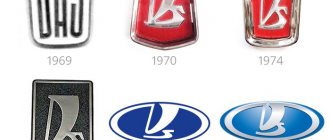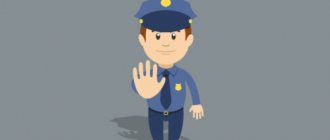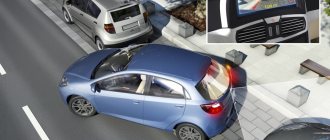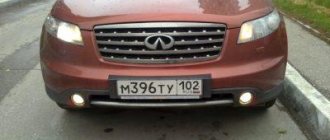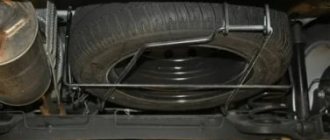Prohibiting varieties
Outwardly, it is very simple to distinguish them - a circle with a red border on a white or blue background, which is quite difficult not to notice. This is a very large group that regulates literally all aspects of road traffic, starting from the maximum permissible speed, restrictions on the weight and types of vehicles, and ending with the ban on entry, parking and stopping of cars on various sections of the road.
It is important not only to confidently imagine what prohibitory signs look like and what exactly they prohibit, but also to understand exactly on which sections of the roadway they operate, that is, to imagine the area of effect of the sign. Let's first figure out where the zone of action of the prohibiting species begins.
Regarding the lanes to which it applies, everything is also quite simple - prohibitory signs only apply to one side of the road, where they are installed.
Of course, there are exceptions to any rule. So, for example, the “Parking is prohibited” type, established at the entrance to the yard, does not apply to persons living in the house or working in an organization located here, if a detour is not provided. There are other exceptions related to the action of this sign, which will be discussed below.
Sign No parking
This road symbol can be found very often - a blue circle with a red border, crossed diagonally by one red stripe. It is clear that it prohibits parking of vehicles on any day of the week.
But sometimes you can find it prohibiting parking, for example, only on odd days, or even days - on them one or two white stripes (vertical) are drawn inside a crossed out circle. Accordingly, one lane is crossed out - you cannot park a car only on odd days, two - on even days.
However, there are restrictions here too - the ban is valid only until the evening - until 19.00, so in order not to break the rules, before 21.00 the vehicle must be driven to the other side of the road - as a rule, a sign with a reverse restriction is installed on it.
Well, in the period from 19.00 to 21.00 you can park your car in the coverage area of any sign - you will not break the rules. It should also be noted that there are categories of people who can safely ignore the “Parking Prohibited” symbol.
We will not describe in detail the rules for federal postal vehicles, for which this type does not apply - this is not relevant for us. It is much more important that cars of disabled people of groups I and II and persons transporting such disabled people can park under this graphic element without fear.
No parking or stopping sign
This type, so to speak, is closely related to the road sign we described above. The fact is that where stopping is prohibited, parking is also prohibited, but not vice versa.
You can stop in a “No Parking” zone and you won’t be fined. Let's take a brief look at how a parking lot differs from a stop.
There are no difficulties here, since this issue is covered in some detail in the traffic rules. Understanding the differences between parking and stopping is very simple.
But if at the same time you perform actions related to boarding/disembarking passengers, loading/unloading a car, then regardless of how much time it takes you, you will make a stop, not a parking lot, even if it lasts at least 15 minutes, at least a whole hour.
Externally, “Parking and stopping is prohibited” is very similar to the prohibitory type we described above, only it is no longer one diagonal red stripe on a blue background, but two intersecting stripes.
It also applies only to its own lane. Exceptions to which this symbol does not apply include only route vehicles. Please note that disabled people in their vehicles can no longer stop in the coverage area of this element, unless, of course, a corresponding information sign is installed under it.
Area of operation of the “No parking” sign
In general, its coverage area is the same as that of other prohibitory images, that is, from the installation site to the first intersection, or to the end of the populated area, if no other symbols are installed that remove the restriction.
However, there are nuances:
- Firstly, the zone can be defined by a yellow broken marking line at the edge of the roadway: as long as it is there, parking is prohibited, and with the end of this line, the sign’s coverage area ends.
- Secondly, at the beginning of the article it was not for nothing that we briefly mentioned other road types, in particular, signs used in conjunction with other types to clarify the action of the latter.
Road sign white circle with red border
Such a sign may be supplemented with additional signs; 1. Sign 8.3.1-3 with arrow indications of the further direction of action. 2. Sign 8.5.1-4, indicating the duration of the installed road sign 3.2. Used when carrying out events, repair work and other things on the covered section of the road.
Interesting: Can a bailiff take away an apartment that is pledged to a bank?
The road sign, a white circle with a red border, does not have a strict covering - the end of the action is considered to be the installation of the corresponding duplicate sign with a mark indicating the end of the action, or the first intersection. Less often - the end of the road with an adjacent sign.
What does it mean
The “Parking prohibited” designation indicates that drivers are prohibited from stopping or parking in the area of its influence:
- You cannot stop driving a car for a period of up to 5 minutes or more, which is associated with unloading (loading) goods or boarding (disembarking) passengers.
- Stopping for more than 5 minutes is prohibited.
The area covered by the “No Parking (Stop)” sign with arrow is defined below.
Coverage area
The parking prohibition symbol looks like a blue circle with a red border, inside which there are two red diagonal lines criss-crossed. Its coverage area begins at the installation site and ends at the nearest intersection. If no road intersections are expected before the destination, then the driver cannot park until leaving the city.
Important to know: The sign only applies to the side of the road where it is located. If on the highway there is a sign “End of the zone of all restrictions,” then the motorist can stop at any place beyond it.
Clarifying designations
What does “No parking” with a down arrow mean? If such a special sign is installed under the road sign, then the prohibition applies from the location of the sign and in the opposite direction of the road (back). The combination means that the zone has ended.
If the sign shows an arrow up or down, and also indicates a certain number of meters, then the driver should not park within this distance (before the sign - if the arrow is down, after it - if the arrow is up). A double arrow (a road sign with an up and down arrow) indicates that the driver is in the area under the influence of a prohibitory sign.
Informing special signs have a rectangular shape and are located directly under the prohibitory sign.
Sometimes there are 2 arrows under the prohibition sign indicating different directions. Usually the number of meters is written on them. Such signs are usually located near buildings that have historical value. That is, they prohibit stopping near the facade at a specified distance.
Attention: Such signs can be confused with the “Distance to object” road sign. It is necessary to study the distance between the arrows and numbers. In the first case it is significantly less.
Related special signs
A parking sign (a white letter “P” on a blue background) will cancel the area where the prohibiting sign is valid. There are also several signs that indicate the area of distribution of a red circle with crossed lines:
- Name of the locality - you cannot park until the vehicle leaves its boundaries.
- The name of the city is crossed out - it is prohibited to stop driving until the driver crosses the exit from the populated area.
- The “End of the zone of all restrictions” sign cancels the effect of the ban.
In the current traffic regulations, the designation “Parking prohibited” is indicated by the numbers 3.27. On a highway, it can be duplicated by a yellow demarcation line, which is applied to the edge of the roadway on the curb or at its potential location.
Signs used in conjunction with the "No Parking" sign
All signs intended for installation with this prohibitory sign are divided into 2 groups. The first includes white rectangles with an arrow(s). If the arrow is directed upward and supplemented with a number, then the sign’s coverage area ends through the distance indicated by the number. The downward arrow indicates the end point of the ban. An arrow pointing both down and up indicates that the car is in a restricted area. A sign with an arrow pointing to the left or right indicates the distance to a building or structure at which a vehicle cannot be parked.
The second group of signs are white rectangles depicting one group of vehicles: tractors, trucks, buses, minibuses, motorcycles. The ban applies only to the group visible in the image.
If there are no signs, the ban ends by default:
- before the next intersection;
- at a sign indicating the beginning or end of a populated area;
- at the sign “End of all restrictions” (this is a white circle crossed out with black stripes).
If the coverage area needs to be extended, another sign is installed.
If stopping for a long time is caused by an accident, congestion or breakdown, this is not considered a violation if there is an alarm or warning sign. The vehicle can be left on the side of the road if it cannot move on its own. Another condition is to exclude the possibility of theft.
Are there any exceptions
The traffic rules contain exceptions for the “No Stopping” sign. For example, if a special sign “Except for the disabled” is installed nearby, this means that citizens with disabilities can park here.
But even without this designation, the ban can be ignored:
- persons with disabilities of groups I and II with identification marks on the car and supporting documents;
- Russian Post vehicles;
- drivers of public transport (trolleybuses, trams, buses). These vehicles may stop near the sign to pick up/drop off passengers.
In all other cases, the prohibition must be followed.
Who can drive under the sign - No movement
- Federal mail drivers do not need to show anything . To identify their professional affiliation, all that is required is the presence of a special car with a white stripe on a blue background diagonally across the body or van.
- Citizens with disability certificates of groups 1 and 2 must have a special sign in the form of a stroller on the windshield of their car, as well as personal documents to confirm their disability.
- Employees of organizations located in the disputed territory , in order to move smoothly in a vehicle through this area, must always carry with them an employment contract or other similar document confirming their affiliation with work at the site.
- Persons living in the territory where such a sign is installed must carry with them a passport of a citizen of the Russian Federation and registration in the given area. A traffic police inspector will never miss an opportunity to stop a vehicle moving within the sign's coverage area. In order to prevent police scams, drivers are required to carry a passport with them.
- When serving the coverage area of sign 3.2 - when delivering from a store located in this territory, being a supplier of goods, products, the driver and forwarder must necessarily have a waybill or waybill with an approved route.
- belonging to federal postal service enterprises, which have a diagonal white stripe on a blue field on the side surface of the body or van;
- service organizations located in the sign's coverage area, confirming their functions with official documents;
- belonging to citizens or serving citizens whose place of residence or workplace is located at the location of the sign;
- driven by disabled people of groups I and II or transporting such disabled people.
Interesting: Unemployment benefits for pregnant women
Penalties
Parking under a prohibited sign may cause inconvenience to other road users. Therefore, for ignoring this sign, a fine will be imposed on the driver. In addition, the car can be towed to an impound lot, which will also entail additional expenses for the motorist (services of a tow vehicle, staying at the impound lot). A sign that warns of the possibility of evacuation (8.24) is installed within the scope of the special sign prohibiting parking.
The standard penalty for parking under a “No Parking” sign is 500 rubles. The Code of Administrative Offenses of the Russian Federation provides for several clarifications:
- The amount of the fine will be increased to 3-5 thousand rubles if only persons with disabilities can park in the designated special zone.
- If a motorist creates a dangerous situation that interferes with the movement of other vehicles, then the amount of the penalty will be 2 thousand rubles.
- If a similar situation arises in a city of federal significance, the driver will need to pay 2.5-3 thousand rubles. with the possibility of auto evacuation.
To summarize, it is important to clarify that the effect of the “No Stopping” sign with an arrow down extends to the territory up to the place where this sign is installed. Drivers must strictly adhere to this rule to avoid receiving an administrative penalty.
Still have questions?
Consult a lawyer (free of charge, 24 hours a day, seven days a week):
8 – Moscow and Moscow region.
8 – St. Petersburg and Len. region
Prescriptive signs give the driver certain directions of movement, a minimum speed, allow further movement only for certain types of transport, and indicate the routes for pedestrians and cyclists. Most mandatory signs are circular in shape and have a blue background with white symbols.
At their core, prescriptive signs perform the same function as prohibitory signs, but only “from the other end.” For example, sign 4.1.2 “Move to the right” instructs the driver that he is only allowed to turn right, prohibiting driving straight and turning left. At the same time, mandatory signs give road services much more flexible options in organizing the passage of intersections and traffic junctions.
Example:
4.2.2 "". Detour is permitted only from the direction indicated by the arrow.
4.2.3 "". Detour is permitted from any direction.
Signs 4.2.1-4.2.3 can be used with vertical markings 2.1.1-2.1.3 or 2.3 on obstacles, the avoidance of which these signs regulate, as well as together with signs 8.22.1-8.22.3 “Obstacle”.
4.3 "". Movement in the direction indicated by the arrows is permitted. This sign indicates an exit to a roundabout intersection, while sign 4.3 does not impose restrictions on the sequence of passage through a roundabout intersection. Drivers driving along it and entering it must follow the general rules for driving through intersections. A warning sign 1.7 may be pre-installed before a roundabout.
4.4 "". Only bicycles and mopeds are allowed. Pedestrians can also use the bike path (if there is no sidewalk or pedestrian path).
4.5 "". Only pedestrians are allowed to move.
4.6 "". Driving is only permitted at the specified speed or higher (km/h).
Sign 4.1.1 obliges drivers to move only in the direction shown on the sign (only straight ahead), with the exception of route vehicles. Does not prohibit reversing.
Installed:
- Directly at the intersection of roadways; extends its effect only to the first intersection;
- Behind the crossroads; extends its effect to the next intersection, but at the same time allows a right turn into courtyards or adjacent areas.
Special conditions prohibiting long stops
There are default rules that prohibit standing:
- closer than 50 meters from the railway crossing;
- near tram tracks;
- before entering bridges and overpasses, entering tunnels;
- on a narrow road, if the vehicle leaves the lane width less than 3 meters free;
- on sections of roads with insufficient visibility;
- on bicycle paths and pedestrian crossings;
- at stops equipped for public transport;
- closer to 15th from public transport stops;
- closer than 5 m from the road intersection;
- in places where a parked car will interfere with traffic, signs or traffic lights will be blocked;
- in places where stopping is prohibited.
Many people are faced with the problem of installing a “No Parking” sign in the courtyard of a residential apartment building. By law it shouldn't be there. There may be markings for special vehicles, but without any additions. The only exception is the decision of the general meeting of residents, at which a decision may be made to prohibit long-term stops in the yard. If it was not there, the restriction is illegal, so a fine cannot be assessed.
If you live in a big city, check out the places where there are "No Parking" signs. This will allow you to quickly find a place that is not covered by the sign's coverage area. This way you can avoid financial expenses (fines in the amount of 500-5000 rubles). It is worth considering that there are situations in which drivers lose their license for 6 months for a long stop in a prohibited place.
The AliExpress portal, in partnership with AvtoFun, has prepared for our readers discounts of up to 60% on all automotive products:
Everyone on the road often encounters a white sign with a red border on a white background. But what does it mean? Let's try to give an explanation.
The designation in the collection “Road Signs” is sign 3.2 Traffic is prohibited. Where a similar road sign is placed, a white circle with a red border, traffic is prohibited. Here are the main reasons for this;
- Forbidden territory.
- Parking lots intended for official vehicles or transport of building residents.
- Traffic control in courtyards, schools, kindergartens, etc.
- Road repair.
- Carrying out various events.
In practice, this means that if you enter the territories marked with sign 3.2 without having a valid reason, at best you can receive a warning.
Answers to examination questions for sign 4.1.1 “Move straight ahead”
Ticket No. 13 Question No. 2
What should you do if you need to turn around?
1. Turn around at this intersection if there are no other vehicles at it.
2. Drive straight and turn around only at the next intersection.
3. Drive straight and turn around after the intersection.
A comment:
Sign 4.1.1 “Go straight ahead” applies to the first intersection and prohibits a U-turn; you must drive straight through the intersection and then turn around.
Ticket No. 15 Question No. 2
In which directions are you allowed to continue driving at the intersection?
A comment:
Sign 4.1.1 “Move straight” is valid only for the first intersection of roadways in front of which it is installed. You are only prohibited from turning right onto the first roadway. In other directions you can continue moving.
Question No. 16 Question No. 2
Which courtyard can you enter in this situation?
1. Just go left into the courtyard.
2. Just go into the courtyard to the right.
4. Turns into courtyards are prohibited.
A comment:
Sign 4.1.1 “Move straight”, installed behind the intersection, prohibits left turns into courtyards and U-turns in this area, but does not restrict entries into courtyards located on the right.
Ticket No. 17 Question No. 9
What trajectory are you allowed to make a turn on?
1. Only at the intersection - along trajectory A.
2. Only before the intersection - along trajectory B.
3. Along any of the proposed trajectories.
4. Not along any of the proposed trajectories.
A comment:
Sign 4.1.1 “Go straight” is installed at the beginning of this section of the road, and its effect ceases at the intersection following it. This means that you can only make a turn along trajectory A. You cannot turn around along trajectory B, since the sign’s instructions are still in effect in this place.
Ticket No. 19 Question No. 2
In which directions are you allowed to continue driving in a passenger car?
2. Only left or right.
A comment:
Plate 8.4.1 “Type of vehicle” with a picture of a truck applies the mandatory sign 4.1.1 “Driving straight” only to trucks with a permissible maximum weight of more than 3.5 tons. Thus, you can drive through the intersection in any direction.
Ticket No. 20 Question No. 2
Are you allowed to enter the yard beyond the intersection?
3. Yes, only if you live in this house.
To get a driver's license and drive around the city in your own car, you must first learn the signs and current traffic regulations. Without knowing them, you will not be able to get a driver’s license from the traffic police, which is why driving schools pay special attention to the topic of studying road signs. Mandatory signs are often particularly difficult; for some reason, some drivers do not pay attention to them, considering them additional.
Signs of special regulations
This group is intended for entering or canceling a special auto mode. They are made in the form of a rectangular shape, predominantly blue, in some cases the background is green.
Signs warn of the following traffic conditions:
- the presence of an expressway and its end;
- availability of roads only for cars, buses, motorcycles;
- one-way highways and exits;
- reverse movement and entering the road with such a move;
- the existence of a highway with a lane for shuttle buses, cyclists and the ability to access it;
- the lane for minibuses or cyclists and its end;
- direction of movement along the lanes and the beginning/end of such a section of the road;
- number of lanes;
- the place where a regular vehicle stops;
- the presence of a pedestrian crossing, an artificial unevenness, a residential area, a populated area, an area with limited parking, including a regulated one, a pedestrian or bicycle section, an area with an eco-class restriction for motor transport.
What are road signs?
A road sign is a graphic design created in accordance with existing state standards. It is installed next to the road to provide drivers, pedestrians and other road users with the information necessary to navigate existing highways safely.
Signs play a huge role in ensuring safe traffic on the roads; with their help, drivers can learn about dangerous sections of highways, where it is necessary to reduce speed due to the high risk of accidents, where overtaking is allowed and where it is prohibited. They also perform a number of important functions.
Mandatory traffic signs
These signs are mandatory, with the exception of cases when traffic regulation is carried out by traffic police inspectors. If you don’t know what mandatory signs look like, they are round in shape, white drawings are displayed on a blue background, and they instruct drivers to perform certain actions.
The most commonly used sign is 4.1.1. "Go straight ahead." According to it, the driver can only move in this direction, while the effect of the sign is not relevant for route vehicles (bus, trolleybus, tram). It is valid from the place where it is installed to the first intersection; in its coverage area it is allowed to turn right into the adjacent territories and into the yard.
Fine for driving under a sign - No traffic: sign 3
What is the fine for driving under a “No Traffic” sign? Not that big, only 1,500 rubles ( Article 12.16 of the Code of Administrative Offenses of the Russian Federation ). Why so few? The authorities believe that despite the violation of the “no movement” sign, this act in itself is not dangerous and the driver does not create an emergency situation. After all, no other cars are expected to be in this zone. But neglecting the “brick” threatens with deprivation of rights.
Don't rush to sign . You can also request that a protocol be written out and sent to you by mail at the place of registration . It’s easier to try to challenge it this way than if you were “accepted” before the circumstances were clarified. If this happens, contact a lawyer as soon as possible.
03 Aug 2020 yslygiur 1033
Share this post
- Related Posts
- What to do if you are insulted
- Benefits for the birth of twins in 2020
- Large families in Chuvashia
- Documents to the registry office for divorce
How to behave if you see such a sign?
Mandatory road signs 4.1.2-4.1.6 have a similar meaning, only in this case it is allowed to move in the directions indicated by the arrows. Those road signs that indicate a left turn also allow you to make a U-turn; in some cases, signs with different configurations of directional arrows are used.
Please remember that route vehicles may ignore these signs. The latter will operate at the intersections of highways in front of which they are installed. It is worth keeping an eye on exactly what signs are installed on the roadway; you need to remember that they can also restrict traffic in one direction or another.
Types of prescriptive signs
Separately, we should highlight signs with which drivers can see obstacles on the road and go around them, guided by arrows indicating the direction. In this case, according to the rules, the detour must be made exactly in the direction indicated by the arrows.
These prescriptive signs are usually installed either next to the obstacle, in some cases they are placed on the extra element of the roadway itself. If necessary, guide bollards or racks with signs indicating the desired direction of movement are installed.
Roundabout Circulation
There are mandatory signs that are installed on the most complex elements of highways, for example, 4.3. "Roundabout Circulation". According to this sign, movement is permitted in the direction indicated by the arrows. It is installed in front of all entrances to intersections where a similar traffic pattern operates.
Novice drivers quite often make a mistake when faced with this sign. If a motorist sees him before a roundabout, he does not have any traffic priority. In this case, we are talking about a crossroads of equivalent roads, where the well-known “right hand” rule applies.
Additional road elements
In large cities, there are other elements on the roads that must be taken into account when traveling by car. In particular, we are talking about the “Bicycle Path” sign, according to which the movement of mopeds and bicycles is carried out in a special lane allocated on the highway. In some cases, pedestrians can also move along this path; drivers should remember this. The sign is installed at the very beginning of the path, it applies to all traffic participants until the nearest intersection.
The “Pedestrian Path” sign notifies drivers that only pedestrians are allowed to travel on a designated section of the roadway. It is usually installed at the very beginning of the road, its effect extends to the nearest intersection with the highway. Drivers are not allowed to enter this area; it is strictly punishable.
Speed Limit
There are mandatory signs that limit the speed of movement on highways and remove this restriction. These are the ones that indicate the minimum speed at which a motorist must move along the highway (or lane therein) on which he is located.
The driver must move at a speed that must be no less than the number indicated on the sign, but not more than the maximum value for the highway on which he is located. Sign 4.6 begins to operate from the very beginning of the restriction zone and ends at the location of another sign - 4.7.
Signs for special vehicles
Especially for vehicles intended for transportation, there are dedicated mandatory traffic signs. With their help, drivers of these vehicles can receive instructions on where exactly they can go. These signs are installed at intersections of major and minor highways.
All vehicles transporting such substances must have special warning signs installed. This vehicle must be driven with all necessary precautions to prevent the leakage of harmful substances and their spread throughout megacities.
“No Parking” sign: features, coverage areas
- Indicating the type of vehicle for which parking is prohibited. These can be motorcycles, trucks, trucks with trailers, route vehicles, etc.
- Coverage area signs. These are vertical arrows on a white background that can point up, down, or both ways. They indicate the direction of the zone in which the sign is valid. Sometimes the sign additionally indicates the distance of the coverage area in meters.
- Warning. As the name suggests, the purpose of these types is to inform about dangers on a section of the road in order for the driver to take appropriate measures to ensure the safety of themselves, passengers and pedestrians.
- Priority signs. Indicate to drivers the order of passage through narrow road sections and intersections.
- Prohibiting. Appropriate traffic restrictions are introduced and also lifted.
- Prescriptive. Establish mandatory driving conditions on a lane or section of road.
- Special instructions. Designed to organize a certain traffic mode, or cancel it.
- Additional Information. These are signs used in conjunction with other types, complementing or clarifying the actions of the latter.
- Information types.
- Identification varieties.
- Service.
Drivers' responsibility
Mandatory traffic rules signs are among the main ones used in Russia. Each driver bears some responsibility for violating traffic rules. For a simple violation, the driver will have to pay a fine of 500 rubles. If a driver turns around or turns left in the area covered by a prohibitory sign, the fine can be up to 1,500 rubles.
If a driver violates the rules and ends up on a lane intended for buses and other route vehicles, the fine in this case can be up to 3 thousand rubles (depending on the city of residence). That is why the driver needs to monitor whether there are mandatory signs on the highway on which he is driving.
Some people break the rules and end up on the roads, moving in the direction opposite to the main flow. Then the driver will have to pay a fine of 5 thousand rubles, or the inspectors have the right to deprive him of his driver’s license for 6 months.
If desired, the driver has the right to challenge the decision made by the traffic police inspectors in relation to him. In some cases, the appeals process takes a long time, so many people prefer to pay the fine quickly and continue driving.
Liability for excess
Traffic signs
Since the speed limit road sign is never set just like that, but only in dangerous areas, or where the movement of vehicles at high speed can lead to human casualties, the punishment for ignoring its requirements is quite severe. This is due to the serious consequences of violating the speed limit, which can be encountered almost every day on our roads. Therefore, the punishment for such a violation is significant - it is quite possible to receive not only an impressive fine, but also to lose the right to drive a vehicle for a period of one year.
The final amount of the fine for this type of violation may vary and depends on a number of factors, for example:
- the specific location of the road where the offense was committed, as well as its category;
- type and characteristics of the vehicle violating the speed limit;
- type of tasks performed by the vehicle - transportation of hazardous substances, people, towing.
It is worth noting that despite the fact that the maximum speed value is specified in the traffic regulations, for different types of roads it can be increased by regions independently. In this case, appropriate signs are installed
This measure in one of the regions is described in the video:
The fine for non-compliance with this clause of the traffic rules also depends on the speed of excess. So, if the excess is insignificant and is no more than 40 km/h, you can get by with 500 rubles. If the vehicle speed differs from the permissible speed by 60-80 km/h, the amount will increase to 2,500 rubles, but this punishment can be changed to deprivation of a driver’s license for up to six months. Exceeding by 80 kilometers or more is punishable very severely - either a 5,000 ruble fine or deprivation of rights for six months. Repeated violations may result in the suspension of your driver's license for as long as a year.
